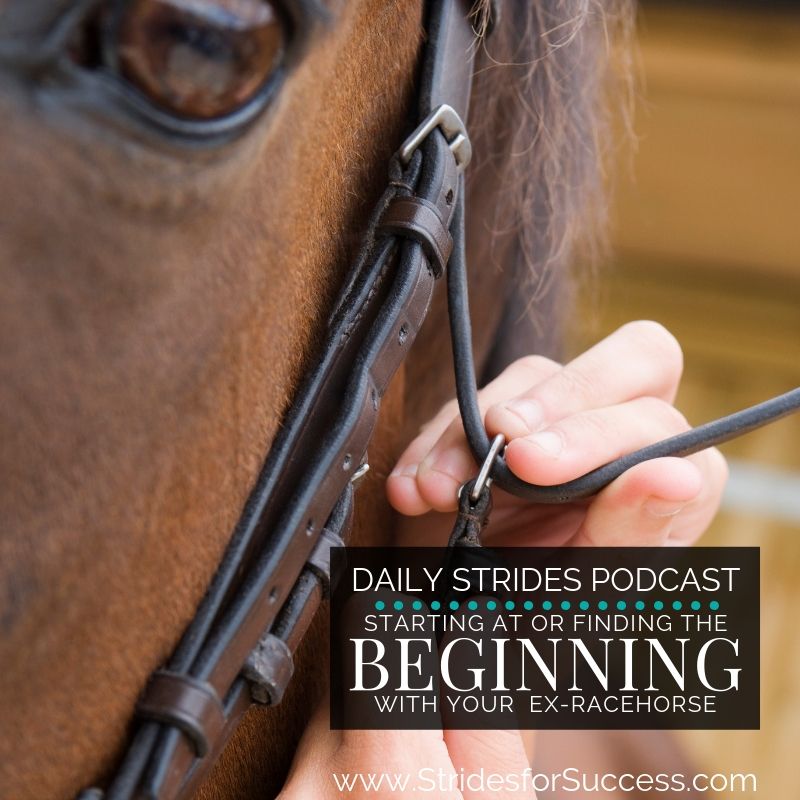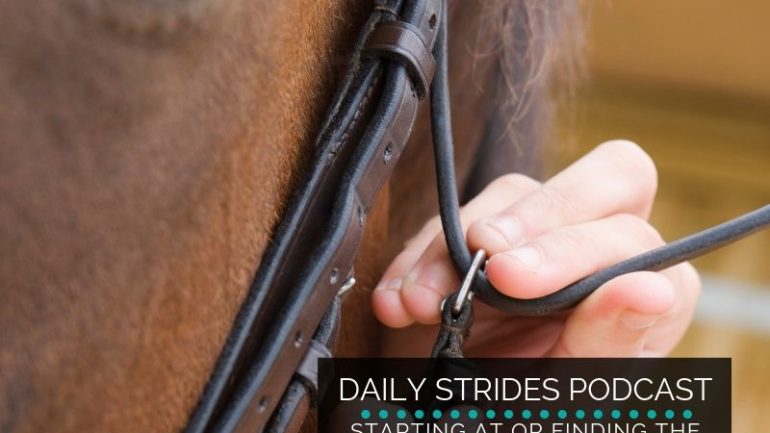
Where should I start? Have you ever found yourself wondering about this with your horse? The beginning is the obvious answer. However, sometimes the beginning is not as simple to pin-point. This is especially true with it comes to your ex-racehorse or OTTB.
Your retired racehorses beginning when he gets to you is not the same as the beginning with other horses. They have already ‘begun’. However, now we are asking them to perform a ‘re-do’. To re-start. At a new beginning…
Thoroughbreds can come to us at so many different points in their careers and lives. They may just be fresh off the track. He might be off a year or two, but was left to his own devices in a field. Possibly he has been worked and ridden by someone else since leaving the track.
Or, your beginning might just be today. You have been working with your ex-racehorse for a while now, and running up against ‘road-blocks’. You want to find a new beginning…
Groundwork & Your Ex-Racehorse
I honestly believe that we can start any conversation with our horses, from scratch, on the ground. It is a place where we can be a little more observant as to what is happening and how we are being understood.
There are so many things you can work on from the perspective of being on the ground, that will then compliment your efforts in the saddle.
Groundwork and lunging will support what is going on in the saddle. This is regardless of whether or not your horse is backed and riding. In order for it to be effective, it must be consistent. Consistent with regards to your expectations, your aids and actually ‘doing the work’.
Your Voice as a ‘Crossover’ Aid
While working on the ground with your horse, you can begin to strengthen your voice aids with your horse. Your voice has the ability to help your horse understand things. It is also a great aid to help settle and instil confidence in your horse as well.
When it comes to your voice, it is not what you say, but how you say it that makes the impact.
Be mindful of your tone and the ‘feeling’ you are putting behind your words. By using your voice to back up your driving aids on the lunge, you can then help your ex-racehorse to better understand those same aids in the saddle.
The same applies with slowing down, steadying and relaxing. Your voice is a powerful aid that you can use to really help your horse to better understand your other aids from the saddle.
Re-Shaping the ‘Contact Conversation’
Lunging is also an excellent way to begin re-training the concept of contact with your OTTB or retired racehorse. So many riders or ex-racehorses really struggle with this. Complaints of arms feeling like they are a couple of inches longer after each ride are common!
It is important to remember that in his previous career, contact was a signal to ‘push harder’.
Your OTTB has learned to ‘take a pull’ where the contact is concerned – and your job is to change this approach for him. However, pulling against the pull is counter productive! It only reinforces what he has already learned.
Allowing Contact to be Neutral
I think that lunging your horse with a bit in his mouth can help to shift how he thinks and feels about the bit. Lunging using a basic bridle, minus the reins and even the noseband, can help this to happen. I also feel that the lunge rope must not initially be attached to the bit. The bit must just ‘be’ there; rather than have any job or meaning.
All horses are different, however you will find that your horse will soon begin to stop ‘fighting’ the bit. Once your horse has accepted the bit as ‘neutral’, you can begin to add contact.
Contact on the lunge can begin as side reins. Good quality side reins have a little ‘stretch’ in them – they soften. Yet, they are also very consistent, which is what you want, especially with an ex-racehorse.
As a rider, we want to create energy and then gather it in the contact. You can do this same thing from the ground, on the lunge.
Using Lunging with Your Riding
All horses are different; therefore different approaches are often needed. However, generally I don’t believe that you only have to lunge your horse when retraining or re-schooling. The lunging is there to compliment and support your riding.
The simple truth is that for most riders, the possibility that their aids are less than crystal clear in the saddle is very high.
Investing a little time lunging each week will help you to continue training your ex-racehorse, even if your aids could do with a little ‘fine-tuning’! Lunging also allows your horse the space to figure things out on his own.
Balance is a key word when working with horses, and working on the lunge allows him to learn this himself. Without the hinderance of a rider being on board…!
So, Where is the Beginning?
It is where ever you want it to be. It is today. Wherever you are right now on your journey with your retired racehorse, groundwork and lunging can only help and benefit you both.
Of course, the work itself has to be correct and right. Personally I don’t believe that ‘loose lunging’ has much benefit for horse or rider. When I say lunging, I mean really learning how to lunge your horse correctly.
Take the time, learn how to work with your horse on the ground and it will really begin to move the conversation forwards for you both.
Happy Riding
Lorna
Other resources, episodes and trainings to help you:-
- FREE OTTB Checklist & Healthcare Journal
- Setting Up Your OTTB for Success Off the Track
- Socialising Your Horse to Riding in a Group
- Working on Relaxation with Your OTTB – www.LornaLeeson.com
- Making Progress with Your OTTB – www.LornaLeeson.com
- Join the free Facebook group HERE
- The Daily Strides Podcast on iTunes
- Daily Strides Podcast on Google Play
- The Daily Strides Podcast on Stitcher Radio
- Join Daily Strides Premium

